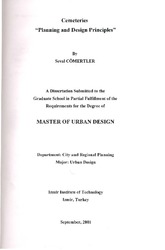Please use this identifier to cite or link to this item:
https://hdl.handle.net/11147/3903Full metadata record
| DC Field | Value | Language |
|---|---|---|
| dc.contributor.advisor | Süel, Akın | en |
| dc.contributor.author | Cömertler, Seval | - |
| dc.date.accessioned | 2014-07-22T13:52:37Z | - |
| dc.date.available | 2014-07-22T13:52:37Z | - |
| dc.date.issued | 2001 | en |
| dc.identifier.uri | http://hdl.handle.net/11147/3903 | - |
| dc.description | Thesis (Master)--Izmir Institute of Technology, City and Regional Planning, Izmir, 2001 | en |
| dc.description | Includes bibliographical references (leaves: 337-352) | en |
| dc.description | Text in English; Abstract: Turkish and English | en |
| dc.description | xviii, 352 leaves | en |
| dc.description.abstract | Cemeteries are special land uses within the urban fabrics, which require a special planning and design approach evaluating the concept in terms of its symbolic, social, cultural, ecological, and recreational aspects apart from t1}ehygienic and functional aspects. Nevertheless, the rapid urbanisation of metropolitan areas in the 20th century Turkey and the parallel transformations in the social, economic, and demographic structures and various other factors have prevented the considerations of cemeteries, which have turned into urban problem areas, as planning and design issues. Consequently, cemeteries in Turkey face problems related to the planning, design, care, management, renewal, and technical subjects, which are based on institutional, legal, intellectual, economic, social and cultural factors. Furthermore, lack of the comprehensive researches particularly in the planning and design disciplines, which may offer a solution to the problems, is another crucial problem. This thesis on the problems of Turkey's cemeteries has two principle purposes: to produce a comprehensive guide book for cemetery studies (both pragmatical and intellectual works), and to develop the planning and design principles for contemporary urban cemeteries by evaluating them with a pragmatical approach. Thesis aims to realise its stated purposes in four phases, these being: constitution of the conceptual, historical, philosophical, cultural, M.d legal basis; determination of the cemetery planning and design principles; testing the principles in Dogan<;ayCemetery; discussion and a fmal evaluation of the fmdings and solutions. Methodology used in the study consisted of three steps. The fIrst step of the method involves the establishment of a conceptual and thkoretical database necessary for further analysis and discussions in the following parts of the study. The second step, which isanalytical, sets the criteria for the evaluation of Izmir's cemeteries. And fmally, the third step includes a pragrnatical approach that proposes a problem solving system for the city of Izmir. | en |
| dc.language.iso | en | en_US |
| dc.publisher | Izmir Institute of Technology | en |
| dc.rights | info:eu-repo/semantics/openAccess | en_US |
| dc.subject.lcc | NA6125 .C66 2001 | en |
| dc.subject.lcsh | Cemeteries--Designs and plans | en |
| dc.subject.lcsh | Cemeteries--Turkey | en |
| dc.title | Cemeteries planning and design principles | en_US |
| dc.type | Master Thesis | en_US |
| dc.institutionauthor | Cömertler, Seval | - |
| dc.department | Thesis (Master)--İzmir Institute of Technology, City and Regional Planning | en_US |
| dc.relation.publicationcategory | Tez | en_US |
| item.languageiso639-1 | en | - |
| item.fulltext | With Fulltext | - |
| item.openairecristype | http://purl.org/coar/resource_type/c_18cf | - |
| item.openairetype | Master Thesis | - |
| item.grantfulltext | open | - |
| item.cerifentitytype | Publications | - |
| Appears in Collections: | Master Degree / Yüksek Lisans Tezleri Sürdürülebilir Yeşil Kampüs Koleksiyonu / Sustainable Green Campus Collection | |
Files in This Item:
| File | Description | Size | Format | |
|---|---|---|---|---|
| T000001.pdf | MasterThesis | 142.79 MB | Adobe PDF |  View/Open |
CORE Recommender
Page view(s)
228
checked on Jul 22, 2024
Download(s)
136
checked on Jul 22, 2024
Google ScholarTM
Check
Items in GCRIS Repository are protected by copyright, with all rights reserved, unless otherwise indicated.